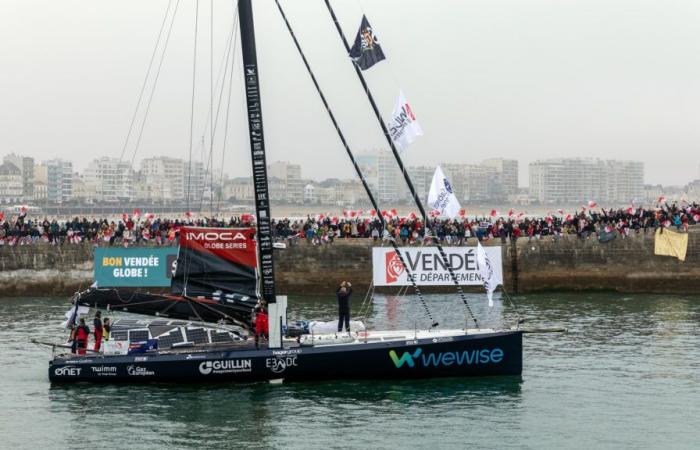Since Sunday November 10, the skippers have set out aboard their sailboat to brave the oceans. To communicate, they use a specific vocabulary, technical terms and maritime expressions. Discover the language of the skippers during this new edition of the Vendée Globe.
What is the Vendée Globe?
The Vendée Globe, often nicknamed “the Everest of the seas”, is a solo, non-stop and unassisted round-the-world sailing race. Created in 1989, this competition leaves from Les Sables-d'Olonne, in Vendée (France) for a journey of several months across the three great capes: Bonne-Espérance, Leeuwin and Horn. The best time is 74 days 03 hours 35 minutes. It was awarded to Armel Le Cleac'h in 2016.
For months, the skippers faced extreme weather conditionsgigantic waves and a trying loneliness. This legendary race is above all a technical feat and a human adventure.
What are the Vendée Globe boats called?
The Vendée Globe sailboats belong to the class IMOCA (International Monohull Open Class Association). These boats are 60-foot monohulls (18.28 meters), specially designed to be light, fast and able to withstand the most difficult conditions.
Since 2016, IMOCAs have integrated cutting-edge technologies such as the foilsthese lateral appendages which allow the boat to “fly” above the waves, thus reducing the resistance of the water and increasing their speed. Each skipper personalizes his IMOCA to adapt it to his sailing style and the specificities of the race.
Vendée Globe vocabulary: the main terms used by the skippers
Discover the jargon of skippers to immerse yourself in the world of the Vendée Globe and better understand the language of sailors:
General marine terms
-
Slouch: quickly lower a sail using a rope and pulley system.
-
Harness : designates the rope used to fix the point of a sail on the windward side.
-
Damage : damage caused to a ship or its goods.
-
Tag: device emitting signals to transmit the skipper's position.
-
Trade winds: regular winds blowing in the intertropical zone, between 23.7° north and south.
Sails and rigging
-
Mainsail: the main sail, located on the central mast.
-
Spi : short for spinnaker, a sail used with a tailwind.
-
Gennaker : an intermediate sail between the spinnaker and the genoa.
-
Foil : appendages fixed under the hull which allow the boat to be lifted out of the water.
-
Bout : term used to designate rope.
-
Ballast : tank filled with sea water on board. It is there to guarantee better stability of the boat.
-
Dismasting: breakage of the boat's mast.
-
Bowsprit: the part of the boat located at the front end to carry large sails forward.
-
Stern: rear part of a boat.
-
Bow: front part of a boat.
Maneuvers and navigation
-
Lofer: bring the ship into the wind.
-
Fell : move away from the wind by changing the angle of the boat.
-
Great Circle Route: the most direct path between two points on the Earth's sphere.
-
Jibe: change direction of the boat with the wind at your back.
-
Tack: move from one side to the other with the headwind.
-
Starboard: right side of a ship when on board
-
Port side: left side of a ship when embarked.
Mythical zones and ocean challenges
-
Cap Horn : a cape located at the southern end of Horn Island, in the Chilean part of the Tierra del Fuego archipelago. It is very feared for its storms.
-
The Roaring Forties: name given by sailors to areas of strong wind between 40° and 50° south latitude.
-
The Screaming Fifties: even windier regions south of 50° latitude.
-
Anticyclone: area of high atmospheric pressure where the weather is sunny and winds generally light. Descending cold air masses increase ground pressure and prevent cloud formation.
-
Depression : zone where, unlike the anticyclone, the atmospheric pressure is low and the winds are strong.
-
ZEA : the acronym for “Antarctic exclusion zone”, where skippers are prohibited from sailing in order to avoid icebergs.
-
Doldrums: an intertropical convergence zone between the northern and southern hemispheres that is accompanied by squalls and unstable weather.
-
Grain : a meteorological event during which the wind suddenly strengthens, marked by a sudden change in direction.
-
Oil: an area where the wind is completely absent.
- Molle : area where the wind is weak and requires sailors to constantly adapt their sails to maintain a minimum speed.
Life on board
-
Waterproof airlock: passage between the interior of the boat and the deck, to protect against waves.
-
Quart : period when the skipper is awake to monitor navigation.
-
Watermaker : device converting salt water into drinking water.
Test your knowledge with the Vendée Globe lexicon quiz
From now on, the terms foil, doldrums, jibe have no more secrets for you. Don't hesitate to test your knowledge on the quiz offered by the Vendée department.
And if you want to learn more about the vocabulary of this sailing trip around the world, many pelagic sources are available for schools and teachers. You will find there Vendée Globe educational sheets for all school levels from cycle 1 to cycle 4.






